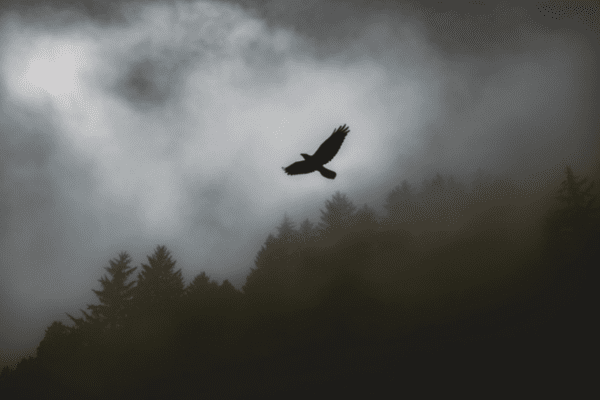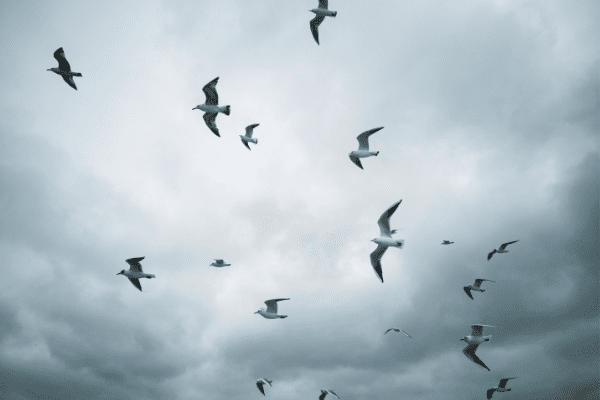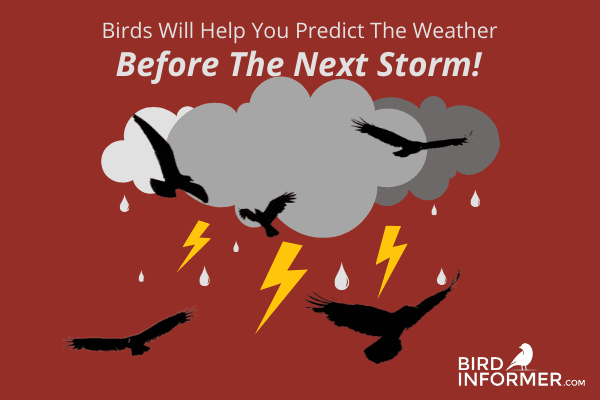Before the age of sophisticated technology where we now have barometers, weather balloons, weather satellites, and a lot more tools to predict the weather, humans depended a lot on the behavior of birds to predict when a storm is coming.
This is exactly why we heard some common bird proverbs that say:
- Hawks flying high means a clear sky. When they fly low, prepare for a blow.
- Birds singing in the rain indicate fair weather is approaching.
- When seagulls fly inland, expect a storm.
In other words, birds became nature’s own barometer.
But the real question is, how do they predict the weather? Well, that’s what we’re going to discuss in this article. We’ll talk about:
- How birds predict weather
- Common bird behavior before a storm
- Different birds and their behavior before a storm
- FAQs
If you’re interested to learn more about this, read on…

How Do Birds Predict Weather?
There is really no scientific evidence that can point out how birds can predict the weather. However, most researchers would say that it’s all about sensing the changes in atmospheric pressure.
It turns out that most birds have a special sensory organ in their middle ear called the Vitali organ. This organ helps them sense atmospheric pressure changes, which somehow signals them what to do next.
The fast decrease in atmospheric pressure means that there would be an approaching storm. These changes can be very painful for the birds in order to relieve discomfort caused by the sudden pressure changes, the birds would need to fly low.
Larger birds would fly lower than usual, while smaller birds would often stay very low to the ground.
Apart from the atmospheric pressure, some birds can also predict the weather by hearing infrasounds that are inaudible to humans. This means that if a massive thunderstorm is only several days away, the birds will know.
Related article: Climate Change & Its Impact On Our Birds
Common Bird Behavior Before The Storm
Because sudden atmospheric changes can cause discomfort, birds react to them differently, which leads to the behavior most of us see in birds before a storm hits. This includes the following:
Perching on Power Lines
Birds perch everywhere, including on power lines. And while you may think this could be a normal occurrence, it’s not really every time. There will be instances when birds perching in power lines would indicate a change in atmospheric pressure.
But how can we tell if the behavior is just normal or not?
First of all, birds may perch on power lines but they really won’t stay there for long. Second of all, not many birds would gather in one power line at the same time.
Now, if many birds start lining up the power lines for a lengthy period of time, then that could be a sign that they felt some changes in the atmospheric pressure. And because these changes can be painful to the birds, they tend to work harder and burn more energy when flying.
When this happens, the closest thing they can perch on are power lines and they stay here for a longer amount of time than usual to bring back their energy.
Sudden Migration
Migration is a seasonal movement where birds move from north to south. They stay in their northern breeding areas in summer where it’s warmer and there’s more food, then once winter comes, they move south to avoid the harsh winter weather.
It’s a regular movement, which is why when birds suddenly leave before migration time, researchers couldn’t help but wonder why.
And yes, this actually did happen already.
In the year 2014, a population of golden-winged warblers in the mountains of Tennessee suddenly migrated while in the middle of their breeding season. Now this is very unusual because no birds would just pack up and leave while in the middle of nesting. And because it’s so unusual, there’s only one conclusion: a big storm was coming.
According to the head of the research, Henry Streby, it was the first time this kind of avoidance was recorded. Normally, birds would just change their course but still follow normal migration, but this time, the warblers flew 1,500 kilometers away to avoid the storm. But when the storm suddenly passed they came back home.
This kind of event is known as evacuation migration, the same thing that we humans do when researchers announce a huge storm coming. The only difference is, birds are able to detect this without any tools.
Seagulls Come In From The Coast
If you’re living near the ocean and you want to know whether a storm is approaching or not, one bird you should watch is the seagulls. Here are some of the behaviors you should watch out for:
- They fly low, just over the surface of the water.
- They stay grounded an hour or so before the storm hits.
- They fly in tight, circular flocks to bring back their sense of balance of direction.
- They come ashore before the strong weather hits.

Spooky Silence
Have you tried standing outside just before the storm hits? What do you hear? Nothing, right? Now that’s exactly why we have a saying that goes, “the calm before the storm”, because before a storm hits there’s utter silence.
No birds are singing or chirping knowing that something dangerous is coming. And this spooky silence is just enough to make you stay indoors.
Different Birds and Their Behaviors Before Storm
- Hawks: Hawks are large birds that generally fly high. But when they suddenly fly low, you need to watch out as that can immediately be followed by a storm. So the next time you go out and see a hawk flying above you, try to observe if they’re flying high or low. If it’s low, then you better go back to your home and prepare for something big.
- Geese: Just like hawks, geese fly higher when the weather is nice. But we think it’s more true if we say that when you rarely see geese around, that means they could already be hiding from bad weather coming.
- Fowls: As these birds can’t fly high, they execute a different behavior when rain is coming. They normally roost in the daytime when they’re expecting rain. They can also become so noisy when they’re outside, and most of them look uneasy.
- Crows: Crows are social or family-oriented birds. So if you ever see a crow flying alone, go back to your home because foul weather is coming.
A lot of people are already experts in determining these behaviors. But if you’re not, you can start looking up at the sky and see if you have great observation skills.
FAQs About How Birds Behave Before A Storm
Why do birds act weird before a storm?
What we consider as weird behavior of birds are actually life-saving behaviors for them. As the change in atmospheric pressure can be very painful for them, it’s only normal that they do something that’s unusual to relieve themselves of the pain. Hence flying lower than usual or even hiding.
What do birds do when they sense a storm?
Birds are smart, and when they sense that something big is coming, they won’t sit and wait until the storm passes. Instead, they will immediately seek shelter in trees, shrubs, and buildings, staying away from areas where they can be hit by falling debris.
Some birds even choose to migrate or alter their migration route to avoid a huge storm.
What does it mean when birds chirp during a storm?
There’s a saying that when birds start singing in the middle of the rain, a fair-weather is already fast approaching. This means that we’ll only have to wait a few more hours or days and the ordeal will be over.
Final Thoughts On How Birds Behave Before A Storm
Birds are nature’s barometer, thanks to their sensitive ears that can sense atmospheric pressure changes and even hear infrasounds.
When atmospheric pressure drops, that’s when we observe some unusual behaviors like:
- Long lines of birds perching on power lines
- Sudden migration
- Seagulls returning to the coast
- Spooky silence
- Flying low
These behaviors have helped farmers and sailors tell the weather even before sophisticated weather tools were invented. They are very smart creatures who know what to do in certain events, and their behavior before and during a storm proves that.
If you’re hiking or traveling somewhere close to nature and you don’t have any weather tools with you, start observing birds and see what they’ll tell you about the weather. And if you find anything unusual, then perhaps that’s time you tell yourself to pack up.
References:
- https://tekdeeps.com/do-you-know-that-birds-predict-the-weather-heres-how/
- https://www.gardeningdream.com/birds-behavior-before-a-storm
- https://news.berkeley.edu/2014/12/18/infrasound-as-early-storm-warning-for-birds/

from BirdInformer.com https://ift.tt/dA93nyg

No comments:
Post a Comment